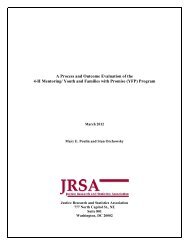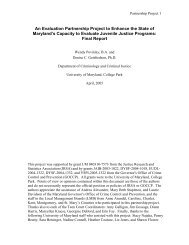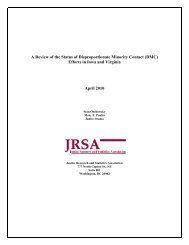Leaving the Gang: Problems and Prospects
Leaving the Gang: Problems and Prospects
Leaving the Gang: Problems and Prospects
Create successful ePaper yourself
Turn your PDF publications into a flip-book with our unique Google optimized e-Paper software.
<strong>Leaving</strong> <strong>the</strong> <strong>Gang</strong>:<br />
<strong>Problems</strong> <strong>and</strong> <strong>Prospects</strong><br />
Scott H. Decker<br />
Arizona State University<br />
Scott.Decker@asu.edu<br />
SCHOOL OF CRIMINOLOGY AND CRIMINAL JUSTICE
Ready, Fire, Aim…An American Solution to <strong>Problems</strong>
Focus<br />
Attempt to address <strong>the</strong> void in <strong>the</strong> literature about<br />
leaving <strong>the</strong> gang<br />
Frame leaving <strong>the</strong> gang as part of a life course<br />
process<br />
Provide a better underst<strong>and</strong>ing as to what<br />
constitutes “former” gang membership<br />
Highlight <strong>the</strong> roles of offending <strong>and</strong> victimization
Characteristics of <strong>Gang</strong><br />
Definitions<br />
Group characteristics.<br />
Symbols of membership.<br />
Persistence of membership.<br />
Self-identification.<br />
Criminal involvement.
What do we need to know to create successful gang Prevention,<br />
Intervention, Suppression <strong>and</strong> Re-entry strategies?<br />
Community characteristics, assets, <strong>and</strong> deficits.<br />
Individual gang member characteristics – race/ethnicity, age, gender,<br />
siblings,<br />
family structure, neighborhood, education.<br />
<strong>Gang</strong> Characteristics – turf, age of <strong>the</strong> gang, initiation rites, exit rites,<br />
link to prison gangs, hanging out.<br />
<strong>Gang</strong> Organizational Characteristics – rules, roles, leaders, meetings,<br />
h<strong>and</strong>ling of money.<br />
<strong>Gang</strong> Activities – crime <strong>and</strong> non-crime.<br />
<strong>Gang</strong> Crime – involvement in gang versus non-gang crime, drugs, guns,<br />
violent crime, property crime, rivalries.
<strong>Gang</strong> Status & Self-Reported Delinquency St. Louis STG Study<br />
34%<br />
70%<br />
5% 40% 7% 34%<br />
80<br />
70<br />
60<br />
50<br />
40<br />
30<br />
20<br />
10<br />
0<br />
% Used Violence<br />
40<br />
35<br />
30<br />
25<br />
20<br />
15<br />
10<br />
5<br />
0<br />
35<br />
30<br />
25<br />
20<br />
15<br />
10<br />
5<br />
0<br />
% Carried Gun % Shot At<br />
<strong>Gang</strong> Status<br />
None Involved Member<br />
What if we reduce gang SRD to pre-gang levels? What is <strong>the</strong> “saving” in<br />
crimes committed?
Organizational Structures of <strong>Gang</strong>s<br />
Corporate Cells Episodic Groups<br />
Super <strong>Gang</strong>s Purposive Local <strong>Gang</strong>s<br />
National Presence Small Cafeteria offending<br />
Older Members Focused Younger members<br />
Long life of <strong>the</strong> <strong>Gang</strong> Specialists Non purposive<br />
p<br />
Prison involvement Isolated Hanging out<br />
Profit motives dominate Criminal events Cafeteria style<br />
How are gang members organized in your community? What is your<br />
source of information about <strong>the</strong>ir organizational structure?<br />
What are <strong>the</strong> implications for underst<strong>and</strong>ing gangs? Human Smuggling?<br />
Terrorism? Drug Smuggling?<br />
What are <strong>the</strong> implications for responding to gangs by law enforcement,<br />
<strong>the</strong> community, social services <strong>and</strong> NGOs for each type?
Six Risk Factors for <strong>Gang</strong> Membership<br />
1. Poor parental supervision ii<br />
2. Early childhood aggression<br />
3. Delinquent belief systems<br />
4. Significant negative life events<br />
5. Peers that are gang members<br />
6. Commitment to street oriented peers<br />
Number, Intensity, Duration, Early Onset
Longitudinal Research on <strong>Gang</strong>s Shows:<br />
1. <strong>Gang</strong> membership, on average tends to be of<br />
short duration, typically less than two years.<br />
2. Five Percent of gang members stay in <strong>the</strong> gang<br />
beyond four years.<br />
3. <strong>Gang</strong> members commit significantly more crime<br />
<strong>and</strong> more serious crime, three to five times more<br />
than <strong>the</strong>ir population share.<br />
4. We don’t predict gang membership very well.
Who is “involved”?<br />
<br />
Serious & Chronic Offenders<br />
<strong>Gang</strong> Leaders<br />
Share of<br />
Illegal<br />
Activity<br />
<br />
<br />
O<strong>the</strong>r Active <strong>Gang</strong> Members<br />
<strong>and</strong> Associates<br />
Children <strong>and</strong> Adolescents at<br />
High Risk for <strong>Gang</strong> Involvement<br />
<br />
General Population of Youth <strong>and</strong> Families<br />
Living in High Risk Areas<br />
Relative Share of Population
Framework<br />
<strong>Gang</strong>s from a life-course perspective<br />
Onset, persistence, <strong>and</strong> desistance<br />
Exiting <strong>the</strong> gang<br />
Sudden vs. gradual departures (Maruna; Decker)<br />
Pushes <strong>and</strong> pulls (Bjorgo)<br />
Implications for leaving <strong>the</strong> gang<br />
Offending <strong>and</strong> victimization<br />
Pro social relationships<br />
Collateral Consequences (neighborhood, family)
What does <strong>the</strong> literature show?<br />
(Not much)<br />
<strong>Leaving</strong> <strong>the</strong> gang occurs as <strong>the</strong> result of:<br />
1. Normal maturational processes (jobs, marriage, family)<br />
2. Growing tired of “<strong>the</strong> life”<br />
3. Exceptional events “extreme violence”<br />
4. Rarely, very rarely, but occasionally programs
What does “former” mean?<br />
The end of:<br />
1. Emotional ties? Feelings, emotions <strong>and</strong> beliefs.<br />
2. Social ties? Being toge<strong>the</strong>r in social space.<br />
3. Joint activity? Acting toge<strong>the</strong>r in a purposive manner.<br />
4. Criminal behavior that supports group objectives?
Conceptual Focus<br />
1. What factors increase <strong>the</strong> number of ties to <strong>the</strong><br />
former gang network?<br />
2. How does <strong>the</strong> number <strong>and</strong> strength of ties increase<br />
criminality? Especially since longitudinal research shows<br />
that gang membership increases F <strong>and</strong> S of offending<br />
<strong>and</strong> victimizations.<br />
How do ties vary in priority, duration, strength, intensity<br />
<strong>and</strong> number?
Ties to Former <strong>Gang</strong> <strong>and</strong> <strong>the</strong><br />
Former <strong>Gang</strong> Network<br />
Definition of <strong>Gang</strong>, <strong>Gang</strong> Member <strong>and</strong> Former Member<br />
Importance<br />
Life course<br />
<strong>Leaving</strong> <strong>the</strong> gang<br />
Victimization risk<br />
Offending risk
The Nature of Ties<br />
Desistance, s <strong>Gang</strong> Ties, Offending <strong>and</strong> Victimization.<br />
A sample of 120 former gang members in Phoenix.<br />
The number of ties declines <strong>the</strong> longer one has left <strong>the</strong><br />
gang.<br />
Social ties to former gang members show a different<br />
pattern than emotional ties. Social ties persist,<br />
particularly for former members who don’t leave <strong>the</strong>ir<br />
neighborhood.<br />
Emotional ties, particularly to family members in gangs,<br />
persist longer <strong>and</strong> stronger.
A Conceptual Focus for<br />
<strong>Gang</strong> Desistence<br />
Controls<br />
<strong>Gang</strong>:<br />
Delinquency<br />
Organization<br />
Neighborhood<br />
<strong>Gang</strong> Ties<br />
Offending<br />
And<br />
Victimization<br />
Length of<br />
desistance<br />
(in months)
Discussion Model<br />
i.<br />
School<br />
Disruption<br />
ii.<br />
iii.<br />
<strong>Gang</strong><br />
Neighborhood<br />
Length of<br />
Desistance<br />
—<br />
+<br />
—<br />
+<br />
<strong>Gang</strong> Ties<br />
+<br />
Offending<br />
<strong>and</strong><br />
Victimization<br />
iv.<br />
Male<br />
+<br />
+<br />
v.<br />
<strong>Gang</strong><br />
Organization
Discussion<br />
<strong>Gang</strong> departure alone is a start, t but not a “cure-all”<br />
Closer to <strong>the</strong> former gang network = more offending <strong>and</strong><br />
more victimization<br />
Intervention efforts should focus on: “knifing-off” gang<br />
ties <strong>and</strong> concentrate on pro-social relationships <strong>and</strong><br />
atmospheres, especially neighborhoods<br />
How do gang ties interact with o<strong>the</strong>r mechanisms such as<br />
How do gang ties interact with o<strong>the</strong>r mechanisms, such as<br />
programming, life course changes (jobs, marriage)
Discussion<br />
The impact of lingering ties to <strong>the</strong> gang<br />
Neighborhood gang activity increases ties, thus making<br />
it harder to leave <strong>the</strong> gang<br />
School disruptions decreased ties to <strong>the</strong> gang<br />
Lengths of months in desistance decreased ties<br />
Increases in gang ties is increases risk for both<br />
victimization <strong>and</strong> offending<br />
Implications for policy: It is not just length of time since<br />
leaving <strong>the</strong> gang, it is reduced ties – social <strong>and</strong><br />
emotional – to gang networks that reduces victimization
Discussion<br />
Pro social ties need to be fostered, particularly for<br />
gang members so that those ties can counteract<br />
gang ties.<br />
Working with <strong>the</strong> gang structure remains a bad<br />
Working with <strong>the</strong> gang structure remains a bad<br />
idea as it reinforces ties among gang members.
















